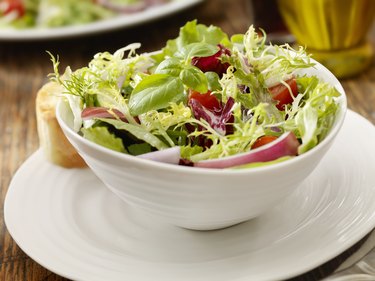
Want to feel fuller on less food? You might be raising a skeptical brow, thinking, Not another weight-loss gimmick. But if you're smart about how and what you eat, you can consume fewer calories — without over-restricting or depriving yourself — and still feel satisfied.
Whether you're watching your weight or just trying to avoid a holiday food hangover, these healthy tips from Chelsea Oarr, RD, CDN, a dietitian at The NY Nutrition Group, will help curb your appetite while keeping your belly rumbles at bay.
Video of the Day
Video of the Day
1. Slow Down
When you eat too fast, your body doesn't have ample time to recognize that you're feeling full. "Slowing down and chewing your food over a longer period allows the gut to send a series of signals to the brain indicating satiety," says Oarr.
As your belly fills with liquids and food, receptors in the stomach are activated and leptin, the satiety hormone, is released. According to Oarr, leptin then communicates with other neurotransmitters and hormones (such as dopamine and cholecysteteine) to induce feelings of pleasure and fullness.
The takeaway? This process requires some time. So, before you reach for seconds, give yourself 20 minutes for your brain and tummy to get on the same page.
2. Drink Water Before Meals
"It's very common to misperceive dehydration as hunger," says Oarr.
If you're feeling famished, first try gulping down a glass of water to ensure you're not confusing thirst for appetite. Doing this before a meal also helps you feel fuller: Since water takes up space in your stomach, it triggers stretch receptors, which then send signals to the brain that you're stuffed, says Oarr.
In other words, with all that H20 occupying room in your belly, you'll need a smaller amount of food to feel satisfied.

3. Satiate With Side Salads
Similarly, veggies have a high volume of water, so tossing greens on your plate is a great way to enhance feelings of fullness and help you control overeating. And since veggies are low in calories, you don't have to skimp on portions. As a matter of fact, research demonstrates that pairing your meal with a nutrient-dense side like a salad helps you reduce your overall calorie intake, according to Oarr.
Plus, veggies contain loads of fiber. And, when it comes to feeling fuller on less food, fiber is your friend. That's because it digests slowly, balances your blood sugar levels, and keeps your appetite in check, says Oarr.
For an extra fiber fix, mix your greens with nuts, seeds and legumes.
Ready to Lose Weight?
Set yourself up for success with more from our 30-Day Weight-Loss Kickstart.
4. Get Enough Sleep
Noticed yourself craving something sweet after a poor night's rest? Sleep is your body's time to reset and re-energize, and when you don't catch enough quality zzzs, you're more likely to crave simple sugars for immediate energy, says Oarr. The problem? Once you devour that donut, your blood sugar levels spike — and then crash soon after, making you yearn for even more calorie-dense, nutrient-deficient sweets.
So, if you can't hit the pillow for the recommended seven hours per night, sneak in a half-hour snooze. Just a 30-minute nap can help reverse the effects of a restless night's slumber, according to a March 2015 study in the Journal of Clinical Endocrinology & Metabolism.
"Distractions such as the television can lead to mindless eating, and, in turn, result in overindulging."
5. Pack Meals With Protein
Like fiber, protein takes longer — and uses more energy — to digest than refined carbs. That's why it keeps your belly happy and staves off hunger.
To feel full, aim to pack your plate with lean proteins at breakfast, lunch and dinner. With plenty of protein and few calories, low-energy-dense foods like fish, poultry, fat-free dairy, egg whites and legumes are your healthiest options, according to the Mayo Clinic.
6. Limit Distractions
Mindful eating is key to helping you feel full. "Distractions such as the television can lead to mindless eating, and, in turn, result in overindulging," says Oarr.
For starters, don't nosh on food in front of the tube. When you're too busy bingeing Netflix, it's easy to miss your body's "I'm not hungry anymore" cues.
Instead, try to pay attention to the taste and texture of your food and savor every bite. If you truly enjoy every mouthful, you'll feel satisfied and be less likely to overdo it.
Oarr also encourages you to stop halfway through your meal and assess your hunger levels on a scale of one to 10 (one meaning you're ravenous, 10 meaning overstuffed and uncomfortable). "Your goal should be to stop eating at a seven where you feel just right — satiated, but with some room left for your next meal," says Oarr.
Was this article helpful?
150 Characters Max
0/150
Thank you for sharing!
Thank you for your feedback!